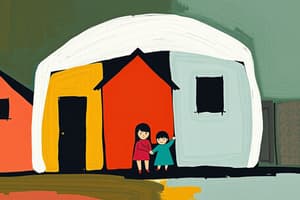Podcast
Questions and Answers
What is the primary definition of a house?
What is the primary definition of a house?
- A structure that holds community services
- An enclosed space solely for shelter
- A building where a person resides (correct)
- A temporary accommodation for activities
How has the concept of 'house' evolved over time?
How has the concept of 'house' evolved over time?
- It now focuses only on physical structures.
- It used to include only minimal physical needs.
- It has become synonymous with community services.
- It has expanded to include various facilities and necessities. (correct)
What is included in the shelter concept?
What is included in the shelter concept?
- Any defined space where physical needs are met. (correct)
- Only the roof and walls of a building.
- Only the physical structure.
- Just rooms within a house.
What encompasses the concept of housing?
What encompasses the concept of housing?
What does the occupancy concept involve?
What does the occupancy concept involve?
What is the definition of the building concept?
What is the definition of the building concept?
Which aspect is NOT typically included in the housing concept?
Which aspect is NOT typically included in the housing concept?
What might indicate failure in providing housing?
What might indicate failure in providing housing?
What is NOT one of the classifications of building types based on their purpose of construction?
What is NOT one of the classifications of building types based on their purpose of construction?
Which factor is NOT used to determine urban housing levels?
Which factor is NOT used to determine urban housing levels?
What classification of buildings includes those designed for specific groups like children or the elderly?
What classification of buildings includes those designed for specific groups like children or the elderly?
Which of the following housing types is characterized by lacking necessary living requirements?
Which of the following housing types is characterized by lacking necessary living requirements?
When evaluating a building's construction method, which of the following is NOT a category mentioned?
When evaluating a building's construction method, which of the following is NOT a category mentioned?
What would typically characterize 'Medium housing' in urban classifications?
What would typically characterize 'Medium housing' in urban classifications?
Which type of building classification does NOT include public utilities or services?
Which type of building classification does NOT include public utilities or services?
Which housing level is associated with the largest flat housing unit size but may still be less inclusive regarding health and safety?
Which housing level is associated with the largest flat housing unit size but may still be less inclusive regarding health and safety?
What factor should be considered when choosing ceiling treatments?
What factor should be considered when choosing ceiling treatments?
What is the minimum ventilation rate required in a dwelling?
What is the minimum ventilation rate required in a dwelling?
What materials can be used for treated interior walls to enhance privacy?
What materials can be used for treated interior walls to enhance privacy?
Which of the following is an effect of high humidity in a dwelling?
Which of the following is an effect of high humidity in a dwelling?
What is a natural method of ventilation in a building?
What is a natural method of ventilation in a building?
Which type of ceiling is not categorized as an ordinary ceiling?
Which type of ceiling is not categorized as an ordinary ceiling?
What is indicated as a physiological comfort level for humidity?
What is indicated as a physiological comfort level for humidity?
What is the primary purpose of ventilation in a building?
What is the primary purpose of ventilation in a building?
What happens to the individual's perception of coldness when humidity increases along with a decrease in temperature?
What happens to the individual's perception of coldness when humidity increases along with a decrease in temperature?
Which type of lighting function is essential for achieving optimal vision of colors and blocks?
Which type of lighting function is essential for achieving optimal vision of colors and blocks?
What is considered the optimal temperature range for human comfort in a balanced environment?
What is considered the optimal temperature range for human comfort in a balanced environment?
Which factor is NOT mentioned as affecting the thermal performance of residential buildings?
Which factor is NOT mentioned as affecting the thermal performance of residential buildings?
Which method is NOT effective in avoiding high temperatures inside dwellings?
Which method is NOT effective in avoiding high temperatures inside dwellings?
What is one of the negative impacts of noise on human health?
What is one of the negative impacts of noise on human health?
What is NOT a result of exposure to noise as described in the content?
What is NOT a result of exposure to noise as described in the content?
How does noise affect productivity according to the content?
How does noise affect productivity according to the content?
What is the maximum permissible level of noise for human hearing?
What is the maximum permissible level of noise for human hearing?
What percentage of the total area of a building should be allocated for infrastructure services?
What percentage of the total area of a building should be allocated for infrastructure services?
Which internal source is NOT considered when discussing noise levels?
Which internal source is NOT considered when discussing noise levels?
Which material can be used to control noise in buildings?
Which material can be used to control noise in buildings?
What is the primary aim of decorative accessories in a residential space?
What is the primary aim of decorative accessories in a residential space?
What should be considered from the early stages of building design?
What should be considered from the early stages of building design?
How does furniture contribute to residential spaces?
How does furniture contribute to residential spaces?
What is a characteristic of home furnishings?
What is a characteristic of home furnishings?
What is a key element of residential units that addresses basic human needs?
What is a key element of residential units that addresses basic human needs?
Which classification method does NOT pertain to residential units?
Which classification method does NOT pertain to residential units?
What aspect of design does the concept of ergonomics primarily focus on?
What aspect of design does the concept of ergonomics primarily focus on?
What defines the concept of 'motor activity' in residential environments?
What defines the concept of 'motor activity' in residential environments?
Which feature of space is considered a determinant of movement?
Which feature of space is considered a determinant of movement?
How is flexibility of design characterized in residential units?
How is flexibility of design characterized in residential units?
In terms of residential space, which human factors are crucial for determining suitable designs?
In terms of residential space, which human factors are crucial for determining suitable designs?
Which element is NOT typically included in the relationship between individual and space?
Which element is NOT typically included in the relationship between individual and space?
Flashcards
House Concept
House Concept
A building where a person lives, including necessary facilities, equipment, and amenities for health and happiness.
Shelter Concept
Shelter Concept
The place that fulfills basic physical needs, including a safe space to stay in for various activities.
Housing Concept
Housing Concept
The process of providing groups with proper houses, plus community services and facilities.
Occupancy Concept
Occupancy Concept
Signup and view all the flashcards
Building Concept
Building Concept
Signup and view all the flashcards
Housing, past concept
Housing, past concept
Signup and view all the flashcards
Housing (modern concept)
Housing (modern concept)
Signup and view all the flashcards
Dwelling Related Concepts
Dwelling Related Concepts
Signup and view all the flashcards
Urban Housing Levels
Urban Housing Levels
Signup and view all the flashcards
Popular Housing
Popular Housing
Signup and view all the flashcards
Economic Housing
Economic Housing
Signup and view all the flashcards
Medium Housing
Medium Housing
Signup and view all the flashcards
Premium Housing
Premium Housing
Signup and view all the flashcards
Building Classification
Building Classification
Signup and view all the flashcards
Urban Buildings
Urban Buildings
Signup and view all the flashcards
Building Size
Building Size
Signup and view all the flashcards
Dwelling Privacy
Dwelling Privacy
Signup and view all the flashcards
Interior Design Considerations
Interior Design Considerations
Signup and view all the flashcards
Ventilation
Ventilation
Signup and view all the flashcards
Ventilation Rate
Ventilation Rate
Signup and view all the flashcards
Ceiling Types
Ceiling Types
Signup and view all the flashcards
Humidity Sources
Humidity Sources
Signup and view all the flashcards
Humidity Comfort
Humidity Comfort
Signup and view all the flashcards
Humidity and Temperature
Humidity and Temperature
Signup and view all the flashcards
Humidity & Coldness
Humidity & Coldness
Signup and view all the flashcards
Optimal Temperature
Optimal Temperature
Signup and view all the flashcards
Temperature Tolerance
Temperature Tolerance
Signup and view all the flashcards
Residential Building Thermal Performance
Residential Building Thermal Performance
Signup and view all the flashcards
Noise Effects
Noise Effects
Signup and view all the flashcards
Noise Definition
Noise Definition
Signup and view all the flashcards
Lighting Functions
Lighting Functions
Signup and view all the flashcards
Lighting Types
Lighting Types
Signup and view all the flashcards
Residential Unit Elements
Residential Unit Elements
Signup and view all the flashcards
Noise Limits
Noise Limits
Signup and view all the flashcards
Noise Sources
Noise Sources
Signup and view all the flashcards
Space Concept
Space Concept
Signup and view all the flashcards
Motor Activity
Motor Activity
Signup and view all the flashcards
Noise Control
Noise Control
Signup and view all the flashcards
Ergonomics
Ergonomics
Signup and view all the flashcards
Infrastructure Needs
Infrastructure Needs
Signup and view all the flashcards
Infrastructure Percentage
Infrastructure Percentage
Signup and view all the flashcards
Human Body Dimensions
Human Body Dimensions
Signup and view all the flashcards
Horizontal Areas
Horizontal Areas
Signup and view all the flashcards
Early Infrastructure Planning
Early Infrastructure Planning
Signup and view all the flashcards
Furniture Importance
Furniture Importance
Signup and view all the flashcards
Home Furnishings
Home Furnishings
Signup and view all the flashcards
Residential Space Design
Residential Space Design
Signup and view all the flashcards
Decorative Accessories
Decorative Accessories
Signup and view all the flashcards
Study Notes
Housing and Environment
- Nagwa Adel Hassan is a professor of Housing and Environment in the Home Economics Department of Alexandria University's Faculty of Agriculture.
Dwelling Related Concepts
- Shelter concept: A traditional concept of housing, associated with fulfilling physical needs.
- House concept: Defines a building where a person lives, including necessities, facilities, and devices for health and family happiness. The definition has expanded over time, encompassing any space where a person resides, even temporarily, for any activity.
Dwelling Related Concepts
- Housing concept: The process of providing sufficient housing for a community that includes residential elements along with community services and facilities.
- Building concept: A structure with a roof and walls, usually permanent and standing in one place.
- Occupancy concept: Establishing people in suitable and equipped housing units. The success rate depends on considering the psychological and social needs of the population.
Classification of Building Types
- Environment: Urban, rural, and Bedouin buildings.
- Occupants: Family, disabled, elderly, and children's buildings.
- Construction method: Load-bearing walls, structural, and vacuum buildings.
- Purpose: Residential, educational, industrial, commercial, recreational, and health buildings.
- Income level: Random, economic, lux, and super lux buildings.
Urban Housing Levels
- Factors determining housing levels: Residential flat area, population income levels, state-provided services and facilities, housing quality, and periodic maintenance.
- Levels: Popular, economic, medium, and premium.
Popular Housing
- Area: 50-70 square meters
- Deficiencies: Limited means for requirements of life and living in a healthy environment (decreased personal space, low quality building and finishing, lack of maintenance, and poor planning).
Economic Housing
- Area: 70-90 square meters
- Characteristics: Accounts for 50% of housing levels in Egyptian cities and primarily inhabited by low-income families; it is also considered a significant burden on the housing problem.
Medium Housing
- Area: 90-120 square meters
- Services: Basic services like sanitation, water supply, electricity, and paved streets.
- Key factors: Location, costs, and finish level.
Premium Housing
- Area: Over 120 square meters
- Accessibility: Limited neighborhoods in Egyptian cities.
- Characteristics: High standard of finishing, favorable location, quality community services, and spacious internal and external areas; it often relies on private contractors for financing.
Housing (Residential) Environment
- Housing is the framework for living, activities, and basic needs (food, clothing, etc.), affecting physical and psychological health.
- Housing elements: Architectural (floors, walls, ceilings), Physical (ventilation, humidity, lighting, temperature, and noise), Infrastructure (services like electricity, water), and Furnishings (furniture, home furnishings, décor).
Architectural Environment - Floors
- Basic requirements: Functionality, beauty, and cost-effectiveness.
- Considerations for flooring: Compatibility with design, ease of cleaning, maintenance, resistance to friction and scratching, ability to withstand traffic and move objects, and thermal insulation.
Architectural Environment - Walls
- External walls: Separate the dwelling from the environment, provide protection from weather, insulation, and privacy.
- Interior walls: Divide the living space, provide internal privacy, and can be treated differently based on the design.
Architectural Environment - Ceilings
- Types: Ordinary and secondary/fallen ceilings
- Considerations: Area, height, costs and noise.
Physical Environment - Ventilation
- Definition: The process of renewing indoor air.
- Ratio: The ratio of window area to floor area should be at least 10%.
- Types: Natural (architectural openings) and Artificial (fans/air conditioners).
Physical Environment - Humidity
- Humidity enters buildings through rainwater absorption, water vapor condensation, and groundwater seepage.
- Comfort level: Generally felt at 50%. Humidity affects physiological comfort, body temperature regulation, and resistance to health impacts based on whether temperature increase or decrease.
Physical Environment - Lighting
- Types: Natural and artificial
- Functions: Allows vision, optimal lighting according to the environment, avoids dazzling, and emphasizes aesthetic elements.
- Patterns: Work surface, directional, and general lighting.
Physical Environment - Temperature
- Optimum temperature: 21-25°C
- Lowest tolerated temperature: 15°C, Highest tolerated temperature: 42°C
- Factors affecting thermal performance: Building direction, architectural openings, ventilation, and building materials.
- Methods to mitigate high temperatures: Using umbrellas, tight frames, artificial ventilation, heat-insulating materials, cool colors, planting, and air envelope systems.
Physical Environment - Noise
- Definition: Noise is a group of sounds causing physiological, neurological, and psychological harm.
- Effects: Anxiety, focus problems, disturbance, elevated blood pressure, increased breathing rate, ear pain, and decreased productivity.
- Limits: The human ear can hear up to 130 decibels, while acceptable noise levels are usually 45 decibels with hazardous levels above 90 decibels.
- Sources: Both internal (e.g., TV, cassette) and external (e.g., cars, shops, factories).
- Solutions: Using sound-resistant/sound-absorbing materials (e.g., wood, textiles, cork).
Infrastructure Facilities and Services
- The performance of a building is contingent on the efficiency of these services.
- Required space for services: 6.5% - 8.5% of the total area.
Furniture and Furnishing
- Furniture: Tangible elements connecting people with space and serving its purpose.
- Home furnishings/Decoration: Essential for beauty, comfort, and assembly.
- Decoration accessories: Used to enhance beauty, direct attention away from defects, and create a welcoming atmosphere.
Family Needs of the Housing Unit
- Maslow's Hierarchy of Needs: A pyramid model outlining five tiers of human needs: Physiological, Safety, Belonging, Esteem, and Self-Actualization.
Residential Unit Elements
- Classifications: Based on basic needs (sleeping/living/service areas), usage times (night/day activities), design flexibility (flexible/inflexible), and occupancy methods (furniture placement/movement areas).
Space Concept
- Space is a part of the surrounding volume, defined by movement and purpose limitations, and must be both visually and physically available.
- This concept involves the sequence of movement and stopping to achieve specific purposes.
Main Determinants of Human Relationship With Housing Space
- Measurement: Dimensions and movement areas for the human body.
- Horizontal study: Length, breadth, and spatial area of horizontal surfaces like floors and ceilings.
- Vertical study: Heights and vertical planes such as walls.
Studying That Suits You
Use AI to generate personalized quizzes and flashcards to suit your learning preferences.



